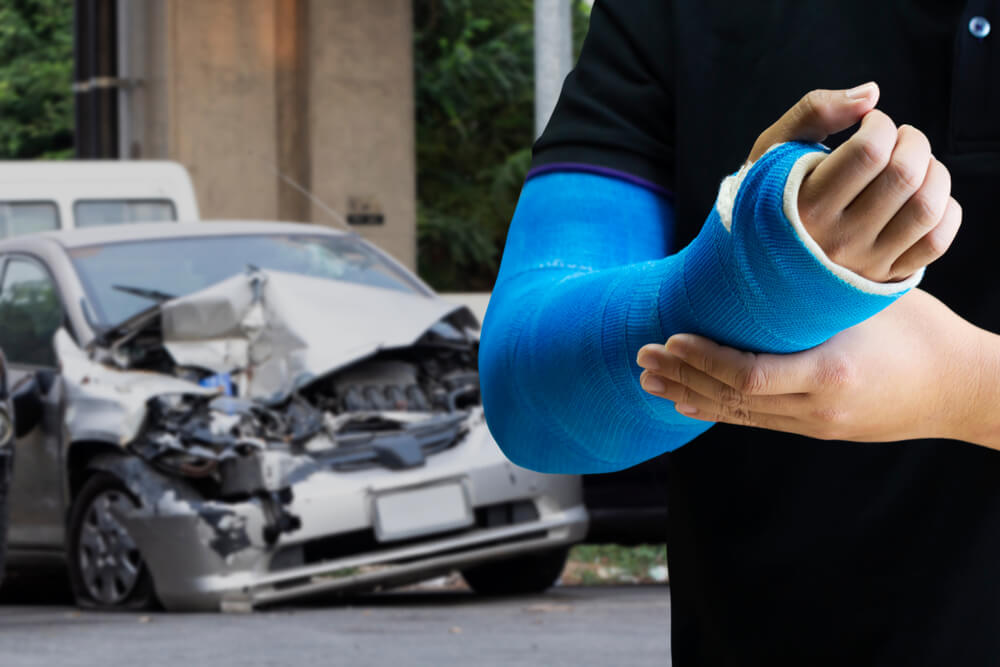
A car accident may cause broken bones as well as soft tissue injuries. While broken bones are considered a serious injury, soft tissue injuries such as torn ligaments or detached tendons can be just as painful and have long recovery times. The violent impact of a car crash is one of the most common causes of soft tissue damage.
Soft tissue damage is sometimes only minor and will heal on its own. Sometimes, however, the injury is serious and may have long-lasting effects. When soft tissue damage is permanent, accident victims are never the same again.
Table of Contents
- 1 What Are The Different Types of Soft Tissue Injuries?
- 2 Why Are Soft Tissue Injuries Dangerous?
- 3 What Are the Symptoms of Soft Tissue Injuries?
- 4 How is a Soft Tissue Injury Treated?
- 5 What is the Most Common Soft Tissue Injury from a Car Accident?
- 6 How Do Soft Tissue Injuries Heal?
- 7 How Do You Tell If a Soft Tissue Injury is Catastrophic?
- 8 What to Do If You Suffer a Soft Tissue Injury After a Car Accident in Indiana?
- 9 Our Indiana Car Accident Lawyers are Here to Help
What Are The Different Types of Soft Tissue Injuries?
Soft tissues such as ligaments, muscles, and tendons can be stretched or torn during a car accident. Whiplash is the most common type of soft tissue injury after car accidents. With this type of injury, the head and neck are snapped back and forth in a violent motion beyond their normal range, which can cause a severe neck sprain or torn tissue.
In some cases, the ligament, tendon, or muscle is extended beyond its range to the point that it partially or completely ruptures. These types of soft tissue injuries may require surgery to repair.
Soft tissue injuries are graded depending on the severity of the injury. The higher the grade, the more serious the injury. The three types of soft tissue injuries grades are:
- Grade I injury: These injuries result in little to no instability in the joints. In most cases, a Grade I injury will heal on its own in just a few weeks.
- Grade II injury: Grade II injuries do involve some instability in the joints. Some of these injuries may heal on their own but if the soft tissue becomes torn, it may require surgery to repair.
- Grade III injury: The most severe of the soft tissue injuries, a Grade III injury refers to a soft tissue that has been completely torn. These injuries almost always require surgery and cause pain similar to a broken bone for the accident victim. Injured individuals typically cannot use the affected part of the body until the injury has healed.
Even with the most minor of soft tissue injuries, a person may feel the repercussions of the damage for weeks.
Why Are Soft Tissue Injuries Dangerous?
People who sustain soft tissue injuries often do not know how serious these injuries can be, which is what makes them so dangerous. After a collision, accident victims should always see a doctor who can perform a full examination and make a correct diagnosis. Without an actual diagnosis, it is impossible to determine what injury was sustained and, therefore, what treatment is appropriate. Soft tissue injuries that are not properly treated will only become worse, and eventually, surgery may be required. Also, the longer someone goes without treatment, the more debilitating their injury will become.
What Are the Symptoms of Soft Tissue Injuries?
It is important that all injured individuals are able to recognize the symptoms of a soft tissue injury. Sharing this information with a doctor will help to diagnose the condition. The most common symptoms of soft tissue injuries include:
- Limited range of motion
- Muscle weakness
- Muscles that cramp or spasm
- An inability to bear weight on the injured part of the body
- A knot or lump at the site of the injury
- Instability in the joints
- Pain
- Visible bruising
- Swelling
How is a Soft Tissue Injury Treated?
Most soft tissue injuries are treated by resting the area and using the “RICE” formula. RICE stands for rest, ice, compression, and elevation. Usually cold is applied to the injury for a certain period of time, and gentle compression helps reduce the amount of swelling at the site. Elevating the injury above the level of the heart can also drain fluid away from the area, which helps reduce swelling. Until the injury has healed, it is best that accident victims rest and avoid using the affected area. However, this often means missing work for a period of time.
In addition to following the RICE formula, a victim may require rehabilitative therapy or even surgery to treat their injuries.
What is the Most Common Soft Tissue Injury from a Car Accident?
Whiplash is the most common soft tissue injury accident victims sustain during a car accident. Although many people think this is a minor injury, that is not true. Whiplash is extremely painful and greatly reduces a person’s mobility. It can also take several months to recover from, and physical therapy is often necessary to restore the full range of motion. Whiplash is extremely common in rear-end accidents.
How Do Soft Tissue Injuries Heal?
Recovering from a soft tissue injury can take a considerable amount of time. In the first few days, soft tissue injuries are known as acute injuries. At this point, you may notice bleeding and swelling, and likely a significant amount of pain. Proper medical treatment is required at this point, which can help lessen the severity of the symptoms.
The second phase starts when the body starts trying to repair the injury rather than protecting it from getting worse. As the body tries to heal, new scar tissue is created and helps strengthen the damaged tissue. In most cases, new tissue will have formed in approximately six weeks.
Once new tissue has formed, the injury is almost completely healed. However, the body will continue to try and strengthen the injury by creating new tissue until a person’s normal functions are restored. This last phase usually lasts anywhere between six weeks and three months.
If you are still in pain three months after the car accident, you may have a chronic condition. At this point, it is important to speak to a lawyer and a physiotherapist to understand the options available to you.
How Do You Tell If a Soft Tissue Injury is Catastrophic?
A catastrophic injury is defined as one that prevents a person from living their life in the same manner they did before the accident. If a soft tissue injury has permanent or long-term disabling effects, it may be considered catastrophic. If a person is in chronic pain, experiences chronic numbness, or has some loss of function after an accident, the soft tissue injury could be catastrophic.
Due to the severe nature of Grade III soft tissue injuries, they may rise to the level of catastrophic injuries with long-lasting effects on a person’s quality of life.
What to Do If You Suffer a Soft Tissue Injury After a Car Accident in Indiana?
The moments after a car accident are scary and confusing. It may be difficult to think clearly. It is normal to be uncertain what to do. The steps you take immediately after an accident can make all the difference in the outcome of any future injury claim you may file.
The most important step to take after an accident is to seek medical attention. The adrenaline you feel after an accident may mask certain injuries. Soft tissue injuries often are not apparent right away. But a day or two after the accident, the damaged tissue may swell and become very painful. Even if you do not feel as though you have been injured, it is still important to see a doctor for a medical evaluation after a car accident.
Going to the doctor is important for your health. It is also important to document your injuries in case you need to file a claim later. If you do not see a doctor, the insurance company will likely argue that you did not seek medical treatment, therefore you must not have been injured. The insurance company also may argue that your own negligence caused your injuries to become worse. If the insurer is successful with either of these arguments, it will greatly reduce the amount of compensation you ultimately receive.
Once you have seen a doctor, the next step is to speak to a top Fort Wayne auto collision lawyer who can review the details of the accident and discuss whether you have a valid personal injury claim.
Visit Our Personal Injury Law Offices
Our Indiana Car Accident Lawyers are Here to Help
If you have been in an accident and have suffered a serious injury such as soft tissue damage, do not hesitate to call our Fort Wayne car accident lawyers.
At Truitt Law Offices, we are dedicated to helping accident victims seek a full and fair settlement. Let our attorneys put our experience to work for you. Call us today or contact us online to schedule a free case evaluation.








